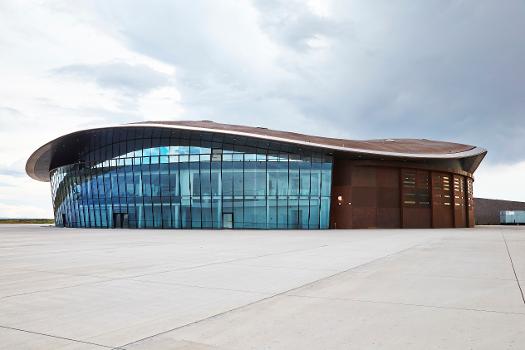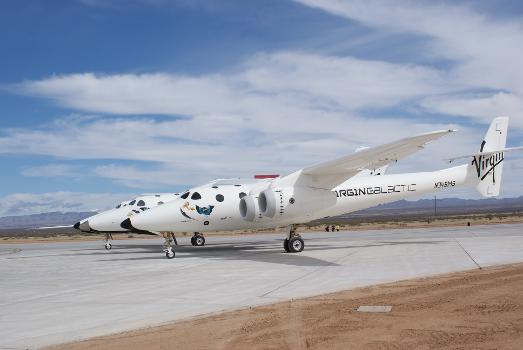General Information
| Other name(s): | Southwest Regional Spaceport; New Mexico Spaceport |
|---|---|
| Beginning of works: | 2005 |
| Completion: | 8 January 2010 |
| Status: | in use |
Project Type
| Function / usage: |
Spaceport / Launch complex |
|---|
Location
Technical Information
Dimensions
| runway | length | 3 048 m |
Excerpt from Wikipedia
Spaceport America is an FAA-licensed spaceport located on 18,000 acres (7,300 hectares) of State Trust Land in the Jornada del Muerto desert basin in New Mexico, United States directly west and adjacent to U.S. Army's White Sands Missile Range. It lies 89 miles (143 km) north of El Paso, 45 miles (72 km) north of Las Cruces, and 20 miles (32 km) southeast of Truth or Consequences.
The site has been described as "the world's first purpose-built commercial spaceport" because it is the first spaceport designed and constructed specifically for commercial users that had not previously been an airport or federal infrastructure of any kind. The site is built to accommodate both vertical and horizontal launch aerospace vehicles, as well as an array of non-aerospace events and commercial activities. Spaceport America is owned and operated by the State of New Mexico, via a state agency, the New Mexico Spaceport Authority.
Current tenants of the spaceport include Virgin Galactic while UP Aerospace and Armadillo Aerospace have all operated from the spaceport.
The site's major tenants have experienced problems—or change of plans—in the development of their programs and technologies, resulting in spaceport revenue far below projections, and political controversy about what to do with the expensive government-built spaceport. Spaceport America was officially declared open on October 18, 2011 and the visitor center became fully accessible to the general public in June 24, 2015.
History
Located in southern New Mexico, Spaceport America is the result of over two decades of efforts to increase the commercial accessibility of spaceflight.
Inception
The spaceport's initial concept was proposed by Stanford University engineering lecturer and tech startup advisor Dr. Burton Lee in 1990. He wrote the initial business and strategic plans, secured US$1.4 million in seed funding via congressional earmarks with the help of Senator Pete Domenici, and worked with the New Mexico State University Physical Science Laboratory (PSL) to develop local support for the spaceport concept.
In 1992, the Southwest Space Task Force was formed to advance the New Mexico space industry's commercial infrastructure and activity. After several years of study, they focused on a 27-square-mile (70 km²) plot of state-owned land, 45 miles (72 km) north of Las Cruces, as a location for the spaceport.
In 2003, the task force petitioned new Economic Development Cabinet Secretary Rick Homans who then picked up the torch. Homans presented the idea to state Governor Richardson and negotiated with the X Prize Foundation to locate the X Prize Cup in New Mexico. Following an announcement by Governor Richardson and Sir Richard Branson that the new Virgin Galactic would make New Mexico its world headquarters, the state legislature enacted laws providing for the world's first purpose-built commercial spaceport in 2006. The spaceport was branded Spaceport America.
Construction
Spaceport America terminal hangar facility as of October 2010. Concrete plant on site for paving of the runway. The "Virgin Galactic Gateway To Space" in October 2010. The runway under construction, March 2010.
Construction of the first temporary launch facility at the spaceport site began on April 4, 2006. Early operations of the spaceport utilized this temporary infrastructure, some of it borrowed from neighboring White Sands Missile Range.
In early 2007, red tape was still in the process of being cleared and the spaceport itself was still little more than "a 100-foot (30 m) by 25-foot (7.6 m) concrete slab." That slab would eventually be part of the launch facility for the spaceport's first tenant UP Aerospace. On April 3, voters in neighboring Doña Ana County approved a spaceport tax that would go into effect upon final approval from the Spaceport America host county Sierra County.
The first images of the then planned spaceport's Hangar Terminal Facility (HTF) were released in early September 2007.
In April 2008, the voters in Sierra County approved the plan, releasing over US$40 million in funding for the spaceport. Voters in the third county of Otero, however, rejected the spaceport tax during November general elections. In spite of this, Spaceport America had what it needed to move forward and great headway towards its completion began.
In December 2008, the New Mexico Spaceport Authority received its launch license for vertical and horizontal launch from the Federal Aviation Administration's Office of Commercial Space Transportation. Shortly thereafter, Virgin Galactic signed a 20-year (240-month) lease as the anchor tenant, agreeing to pay US$1 million per year for the first five years in addition to payments on a tiered scale based on the number of launches the company makes.
In December, Gerald Martin Construction Management, from Albuquerque, was chosen to oversee construction. As of April 2009, the first of 13 bid packages for the spaceport was expected to be publicly released later that month and all 13 bid packages were scheduled to be released by June 2009. "The goal is to have [construction] completed in 17 months, by December 2010."
The ground-breaking ceremony took place June 19, 2009 and paid tours of the facilities began in December of the same year.
By February 2010, the in mid-construction budgetary estimate for completion was $198 million.
On October 22, a ceremonial flypass of Spaceport America was made by SpaceShipTwo to celebrate the completion of the runway.
By October 2010, with the runway complete and the terminal building under active construction, the budgetary estimate for completion increased to $212 million. Approximately two-thirds of that were provided by the state of New Mexico and the remainder from "construction bonds backed by a tax approved by voters in Doña Ana and Sierra counties."
As of August 2012, Spaceport America is substantially complete and the cost of the entire project was $209 million.
Increased private funding
With the beginning of the administration of New Mexico Governor Susana Martinez in 2011, the state government took a new approach to increase private investment to complete the spaceport project. In order to oversee the new effort, Governor Martinez appointed an entirely new board of directors for the Spaceport Authority and removed Executive Director Rick Homans.
By 2013, the Spaceport had signed SpaceX as an additional tenant for vertical takeoff and vertical landing flight testing of prototype reusable rockets such as the Falcon 9 Reusable Development Vehicle. The facilities at Spaceport America were never used for Falcon 9 RDV and equipment staged was eventually moved back to Texas.
Delays in operation of the anchor tenant
There have been a series of delays in Virgin Galactic beginning flight operations at Spaceport America. The multi-year extension of the test program and the re-designed engine announced in May 2014 were responsible for much of the delay. In 2014, the spaceport announced that it was seeking additional tenants and hoped to sign another one in the next year.
Budgetary difficulties in operating the spaceport have become salient in New Mexico politics. The annual cost of providing fire protection services that have been contracted for the mostly unused spaceport is approximately US$2.9 million.
The inflight breakup and crash of the first SpaceShipTwo vehicle—VSS Enterprise—in October 2014 has raised questions about the future of the spaceport. With further delays to the start of Virgin Galactic commercial operations, ostensibly to at least 2016, the spaceport may need funding from state or local authorities in New Mexico in order to keep the basic fire and security and administrative operation underway. The Spaceport Authority asked the New Mexico legislature in November 2014 for US$1.7 million in emergency funds to maintain operations until 2016, the earliest date at which Virgin is expected to be able to begin commercial flight operations.
SpaceX has also been delayed in initiating test flights of F9R Dev2 at the spaceport from when they were originally anticipated.
In May 2015, budgetary details made public revealed that the substantially unused spaceport has an annual deficit that has been running approximately US$500,000, with the deficit being made up by state taxpayers. The primary planned revenue in the times of delayed operations by Virgin Galactic and SpaceX, with limited operations by other minor tenants, is local tax revenue, paid by the taxpayers of Sierra and Dona Ana counties.
In May 2019, Virgin Galactic announced that they were finally ready to relocate all of their spaceflight activities to the spaceport.
Facility
The site area nets approximately 670,000 sq ft (62,000 m²), with the terminal & hangar facility grossing an area of 110,152 sq ft (10,233.5 m²).
The western zone of the Facility (25,597 sq ft.) houses support and administrative facilities for Virgin Galactic and the New Mexico Spaceport Authority. The central zone contains the double-height hangar (47,000 sq ft.) to store White Knight Two and SpaceShipTwo craft. The eastern zone (29,419 sq ft.) encompasses the principal operational training area, departure lounge, spacesuit dressing rooms, and celebration areas.
The onsite restaurant and mission control room have direct east views across the apron, runway and landscape beyond.
The spaceport was built with environmental sustainability in mind. Designed to meet the requirements for LEED Gold Certification, it incorporates "Earth Tubes" to cool the building, solar thermal panels, underfloor radiant cooling and heating, and natural ventilation.
A visitor center was planned in downtown Truth or Consequences (the closest town) to provide shuttle bus services to the Spaceport. However, due to delays in spaceport operations and reduction in spaceport authority revenues, the plans were considerably scaled back in January 2014. Rather than the planned US$20 million facilities, the revised plan in January 2014 had only a US$7.5 million capital budget. Rather than the "planned $13 million visitor center at the spaceport [there will be a] $1.5 million hangar" and the Truth or Consequences visitor center budget request was cut to US$6 million from the original US$7 million. By May 2015, news media were reporting that the spaceport authority "spent so much money with a company to design the visitors’ experience that it had no money left over to actually build the facilities for it."
The spaceport is located under FAA Special Use Airspace Restricted Areas 5111A and 5111B. When both these areas are active the airspace is restricted from surface to 'unlimited'.
Text imported from Wikipedia article "Spaceport America" and modified on July 22, 2019 according to the CC-BY-SA 4.0 International license.
Participants
Currently there is no information available about persons or companies having participated in this project.
Relevant Web Sites
Relevant Publications
- (2010): Von der Wüste in den Weltraum. Virgin Galactic und der umweltfreundliche »Spaceport«. In: [ Umrisse ], v. 10, n. 4-5 ( 2010), pp. 46.
- About this
data sheet - Structure-ID
10045524 - Published on:
21/06/2009 - Last updated on:
31/01/2023









